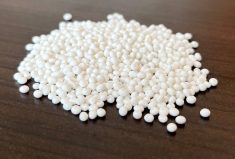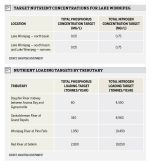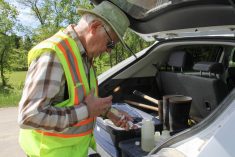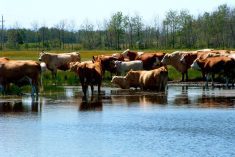Recent flooding has driven Lake Winnipeg’s already high nutrient levels even higher, says Michael Stainton of Freshwater Institute, Fisheries and Oceans Canada.
“I think we’ve demonstrated that the major change we’re seeing in the lake is driven by changes in the flow of the Red River,” Stainton told hog producers at the 2012 Swine Seminar in Winnipeg.
But the researcher noted phosphorus levels in the Red River are increasing as well. During flooding, the river’s phosphorus levels are in the same range as effluent from sewage treatment plants.
Read Also

Pig transport stress costs pork sector
Popular livestock trailer designs also increase pig stress during transportation, hitting at meat quality, animal welfare and farm profit, Agriculture and Agri-Food Canada researcher says
Although hog operations have been labelled by some as significant phosphorus contributors, Stainton said individual phosphorus sources can’t be identified.
“No doubt there has also been a a steady increase in phosphorus concentration in the Red (River), but it does not appear to be synchronized or have a signal that coincides with any one practice,” he said.
“If we could put a tracer on for this phosphorus or that one, and say this phosphorus comes from cattle, this one from the City of Winnipeg, that one from pigs and those from fertilizer, we would be able to say exactly where it’s coming from. But we can’t.”
Provincial legislators passed the Save Lake Winnipeg Act last fall, which many hog producers believe unfairly targets their industry. The move followed a provincially commissioned study of Lake Winnipeg by Canada Research chair Peter Leavitt, who recommended a 50 per cent reduction in phosphorus levels to curtail algae blooms and return the lake to a pre-1990 state.
Dry weather would help
Manitoba Pork Council’s sustainable development manager Michael Teillet said because increases in Lake Winnipeg’s phosphorus levels coincided with hog industry growth roughly 10 to 15 years ago, there has been a tendency to link the two, regardless of scientific evidence.
He argued a prolonged wet cycle, and not increased hog production, is to blame.
“If we went through a drier cycle, the phosphorus counts would probably drop by themselves,” said Teillet.
Given the role flooding plays in increasing nutrients, Stainton said more attention should be paid to fields where water collects before running downstream. The less phosphorus that can be leached from the soil, the better for the lake, he said.
“There are lots of reasons to be managing the loss of phosphorus from the landscape,” Stainton said. “If it’s lost from the field, it’s not available for a crop. A loss of phosphorus from the soil can also coincide with soil erosion. So the things you can do to try and keep phosphorus on the landscape, in terms of soil conservation and flood mitigation, pay multiple benefits.”
Another contributing factor is human changes to the landscape, including 27,000 kilometres of drainage dug in Manitoba over the last century. Short-term storage of flood water on agricultural land needs to be replaced with long-term water storage in wetlands or non-agricultural reservoirs, Stainton said.
An example of this strategy can be found on the Saskatchewan River, which has many natural and human-made reservoirs allowing nutrients to settle out or be reabsorbed before water reaches its destination.
Describing his approach to Lake Winnipeg as a reasoned path through a “minefield” of conflicting positions, Stainton said that although the lake is changing, change doesn’t always equal harm. He said more work needs to be done to assess the impact of higher phosphorus levels.
Commercial fishers have expressed concerns about algae blooms, and changes in the types of algae in Lake Winnipeg, but they are also experiencing increased walleye yields.
Although Stainton didn’t comment on the possibility of a phosphorus “tipping point,” he did note Lake Winnipeg is facing multiple issues.
“I think the tipping point issue is more likely to be one of invasive species, because if it’s nutrients we have some means of mitigating that,” he said. “If it’s a new species, we have no means of mitigating that.”
Attitudes about the health of the lake and the role of hog producers have changed in the last two to four years, according to Teillet. Discussions about Lake Winnipeg have become more science based and are looking towards water management as a whole, he said.
And that is positive for producers like Benjamin Cortez, who farms near the U.S. border.
“What I hear is people blaming farmers for the lake being dirty, but what I see people practising is good and responsible,” he said. “As farmers, we have to do our share of really protecting the water.”


















